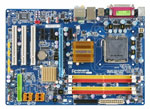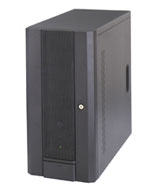Intel Budget Gaming
Traditionally, Intel offerings have tended to be on the more expensive side than configurations from AMD. However, as you shall see, this time the shoe is on the other foot, and we have a very competitive offering from Intel. It's no longer necessary to compromise performance in concession to the almighty dollar, and we are looking at two very strong budget gaming rigs from AMD and Intel.
| Intel Budget Gaming PC |
| Hardware |
Component |
Price |
Rebates |
| Processor |
Intel Core 2 Duo E4500
(2.2GHz 65W Allendale 2MB L2) |
$127 |
- |
| Motherboard |
Gigabyte GA-P35-DS3L
Intel P35 ATX |
$90 |
- |
| Memory |
Crucial Ballistix 2GB (2x1GB) DDR2-800 PC2-6400 |
$90 |
$40 |
| Video Card |
PNY GeForce 8800GT 512MB PCI-e 2.0 HDCP |
$260 |
- |
| Hard Drive |
Samsung SpinPoint T Series HD321KJ
320GB 16MB 7200RPM SATA 3.0GB/s |
$75 |
- |
| Optical Drive |
Samsung 20X DVDRW/DL SH-S202G |
$28 |
- |
| Case |
APEX TU150 Black Steel ATX with 400W |
$59 |
- |
| Display |
Acer 20" AL2016WBbd 5ms Widescreen DVI
(1680 x 1050) |
$200 |
- |
| Speakers |
Logitech X-530 70W RMS 5.1 |
$55 |
- |
| Input |
Logitech LX-710 Laser Black USB |
$55 |
- |
| Operating System |
Microsoft Vista Home Premium OEM |
$112 |
- |
| Bottom Line |
$1151 |
$1111 |
 |
Yes, we know we could have gone with the E6550, but that inches our budget up to nearly $1200 - close enough to our last midrange setup to make the difference rather meaningless. The E4500 clocks in at 2.2GHz and uses the Allendale core with just 2MB of L2 cache, while officially only supporting the older 800MHz Front Side Bus. The Allendale also lacks support for Intel's Virtualization technology, but some users are reporting the G0 stepping includes this. With our requirements, this is a moot point as it is mainly for use in server environments. The E4500 has proven to be a good overclocker and regularly overclocks in excess of 3.2GHz. Strangely, Newegg is listing the E4500 as $2 cheaper than the 2GHz E4400.
 |
With Intel G31/G33 motherboards providing woeful IGP performance compared to offerings from NVIDIA or AMD, how does Intel's enthusiast non-IGP chipset perform? Thankfully, it performs extremely well. Carrying on from the highly successful P965 series, we have the P35 chipset. Seemingly built with overclocking in mind, abit, ASUS, DFI, and Gigabyte have managed to produce a very nice selection of P35 motherboards for gamers. However, for our budget, we are limited to just a couple of options: the abit IP-35E or the Gigabyte GA-P35-DS3L. In the end, we chose the latter, because even though it is at the bottom of the P35-DS3 range from Gigabyte, it has proven to have all the vital features and overclocking ability of its more expensive brethren - and at a very attractive price.
 |
By this time, you may be wondering why we chose not to include an aftermarket CPU heatsink to go along with our CPU choices. For this budget, a $50 solution from Thermalright or Scythe was simply not an option, but with the stock AMD and Intel heatsinks incorporating heatpipe technology, we figured we'd still be good for a decent if not spectacular overclock.
The rest of the components are the same as those found in the AMD budget gaming system, and with AMD's HD 3800 (RV670) series still a couple of weeks away, the 8800 GT was an easy choice. Considering that overclocking will stress the CPU, motherboard, and RAM, it may be a wise investment to upgrade the power supply to something from Seasonic, Corsair, Enermax, or even Antec. Sound cards at this budget are simply an unnecessary luxury, and although a Creative Sound Blaster X-Fi would be an addition to complete our configuration, we're happy with onboard offerings - not to mention those soundcard driver issues we mentioned at the beginning; those were issues with the X-Fi.













63 Comments
View All Comments
crimson117 - Thursday, November 8, 2007 - link
I think the gaming config should include windows, but the basic non-gaming one with integrated motherboard graphics is definitely not meant for gamers.stapuft - Thursday, November 8, 2007 - link
AMD 5000+ Black does not include Heatsink/Fan, price goes up!JarredWalton - Thursday, November 8, 2007 - link
Text edited for purposes of addressing this. I actually didn't even realize the Black had no HSF. Then again, I have about a dozen extra retail HSFs floating around....foofoo - Thursday, November 8, 2007 - link
Thank you. Article came at just the right time. A few nit picks,Wrong heat sink and too many SATA ports (including RAID)
Probably the P35-DS3R or a P965 series.
JarredWalton - Thursday, November 8, 2007 - link
Fixed. :)Spacecomber - Thursday, November 8, 2007 - link
Is 2GB of memory realistic on a Vista based gaming machine, especially with a 512MB video card and 20" LCD monitor?Parhel - Thursday, November 8, 2007 - link
I'm running Vista 64-bit with 2GB, and RAM hasn't been a limiting factor for my system. 2GB is enough for now - even more so for a budget machine.If I were building a new system I might go with 4GB only because the prices are so low, but I wouldn't expect a big performance boost from that.
Spacecomber - Thursday, November 8, 2007 - link
Even though this is listed as a Budget Game System, it comes with a 8800GT and a 1680x1050 resolution LCD, and I would assume that these items will dictate the resolution and quality levels being used in the game's settings. My concern is whether the memory requirements for Vista and a high-end game might cause page file hits in order to keep up at these demanding settings.I'm sure the system will run as it is listed (especially with MS fix to deal with crashes previously seen on systems with lots of video card memory, while running memory hungry games and Vista); however, the stuttering caused when the swap file has to be used to supplement physical memory would be intolerable for most people when they are in the middle of playing computer games, especially online.
These are the circumstances that I'm wondering about, since I think that most gamers would quickly find themselves going back to buy more memory, if this is what they ran into.
Sunrise089 - Thursday, November 8, 2007 - link
Yes, it's 100% fine in a budget build.mostlyprudent - Thursday, November 8, 2007 - link
Please fix the tables and page titles! I may have missed it in all the mixedup tables and titles, but I found no discussion about any of the case/psu choices.